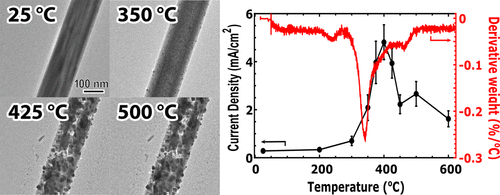当前位置:
X-MOL 学术
›
ACS Catal.
›
论文详情
Our official English website, www.x-mol.net, welcomes your
feedback! (Note: you will need to create a separate account there.)
Direct Observation of Ni–Mo Bimetallic Catalyst Formation via Thermal Reduction of Nickel Molybdate Nanorods
ACS Catalysis ( IF 11.3 ) Pub Date : 2020-08-14 , DOI: 10.1021/acscatal.0c02264 Rituja B. Patil 1 , Stephen D. House 1, 2 , Aayush Mantri 1, 3 , Judith C. Yang 1, 2 , James R. McKone 1
ACS Catalysis ( IF 11.3 ) Pub Date : 2020-08-14 , DOI: 10.1021/acscatal.0c02264 Rituja B. Patil 1 , Stephen D. House 1, 2 , Aayush Mantri 1, 3 , Judith C. Yang 1, 2 , James R. McKone 1
Affiliation

|
We used in situ environmental transmission electron microscopy to image the formation of a Ni–Mo composite nanocatalyst via thermal reduction of NiMoO4 nanorods. Two clear structural changes were observed as the temperature was increased from 25 to 500 °C in the presence of H2(g): the first involved nucleation of nanoscale Ni-rich particles and the second involved general collapse of the remaining oxide phase along with substantial coarsening of the alloy particles. The activity of the catalyst toward alkaline hydrogen evolution was found to reach a maximum in a narrow range of reduction temperatures from 375 to 425 °C. This resulted in the formation of a mixed-phase product comprising sub-10 nm Ni0.9Mo0.1 particles embedded in a porous Mo-rich oxide matrix. Thus, the most active Ni–Mo catalyst apparently requires intimate contact between the alloy component and the oxide phase, lending support to a catalytic mechanism involving metallic and oxidized surface sites.
中文翻译:

通过钼酸镍纳米棒的热还原直接观察镍钼双金属催化剂的形成
我们使用原位环境透射电子显微镜通过热还原NiMoO 4纳米棒来成像Ni-Mo复合纳米催化剂。在H 2(g)存在下,当温度从25升高到500°C时,观察到两个明显的结构变化:第一个涉及纳米级富Ni颗粒的成核作用,第二个涉及剩余氧化物相的整体塌陷以及合金颗粒的大量粗化。发现在375至425℃的狭窄还原温度范围内,催化剂对碱性氢释放的活性达到最大值。这导致形成包含亚10 nm Ni 0.9 Mo 0.1的混合相产物颗粒嵌入多孔富钼氧化物基质中。因此,最活跃的Ni-Mo催化剂显然需要合金成分与氧化物相之间的紧密接触,从而为涉及金属和氧化表面部位的催化机理提供支持。
更新日期:2020-09-20
中文翻译:

通过钼酸镍纳米棒的热还原直接观察镍钼双金属催化剂的形成
我们使用原位环境透射电子显微镜通过热还原NiMoO 4纳米棒来成像Ni-Mo复合纳米催化剂。在H 2(g)存在下,当温度从25升高到500°C时,观察到两个明显的结构变化:第一个涉及纳米级富Ni颗粒的成核作用,第二个涉及剩余氧化物相的整体塌陷以及合金颗粒的大量粗化。发现在375至425℃的狭窄还原温度范围内,催化剂对碱性氢释放的活性达到最大值。这导致形成包含亚10 nm Ni 0.9 Mo 0.1的混合相产物颗粒嵌入多孔富钼氧化物基质中。因此,最活跃的Ni-Mo催化剂显然需要合金成分与氧化物相之间的紧密接触,从而为涉及金属和氧化表面部位的催化机理提供支持。











































 京公网安备 11010802027423号
京公网安备 11010802027423号